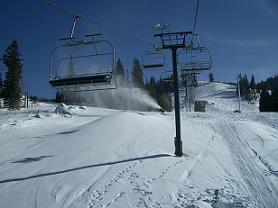The Art of Snowmaking
Snowmaking technology is used to accellerate Mother Natures’ mountain snowfall
Larry Alserda, Salt Lake City Public Utilities Hydrology Specialist
January 8, 2007
|
Since 1989, I have been part of this fall ritual. As the hydrologist at Public Utilities, it is my responsibility to keep track of the water being used for snowmaking. This includes all the flow measurements (metering, stream gauging, and diversions), billing and contract compliance, as well as controlling releases from Lake Mary.
Located in Big Cottonwood Canyon, Lake Mary is the primary source of water for Brighton’s snowmaking as well as one of Solitude’s sources. Solitude’s main snowmaking water comes from a tunnel.
In Little Cottonwood Canyon, Alta and Snowbird resorts use water mostly from mine tunnels and Cecret Lake (also called Flora Lake). This lake is a popular summer hiking place in the Albion Basin at the base of Devil’s Castle. It holds 60 acre-feet of water with a very small dam and is habitat for Noots.
Even though Alta receives over 600 inches of snow during the winter, snowmaking allows the ski resort to open early in the season when winter is just staring to provide natural snow.
Each ski area has a pumping system with pump stations designed similar to a municipal water distribution system. There are two main types of snowmaking machines, or guns, as they are called. One is the fan gun, which to me looks a bit like a jet engine. The other is a stick gun, which looks like a flimsy street light pole. Each is capable of using as much as 30 gallons per minute depending on which nozzle is used. Both types of guns atomize the water into a mist, and then it is shot up into the cold air to freeze and fall as snow on the ski slopes. Some water is vaporized and lost to the atmosphere. All of the ski resorts have more than a dozen snowmaking guns. They are used mostly at night when it’s colder (below freezing temperatures). The artificial snow has a much higher percentage of water than the famous dry Wasatch powder, so it is some of the last snow to melt in the spring and can actually slow potential flooding during runoff.
So, if you are a skier or boarder, you can appreciate the efforts of those ski area employees who work many overnight shifts in cold and wet conditions to get the slopes ready for you to carve turns on before fall semester is over and the out of state holiday crowds arrive.
